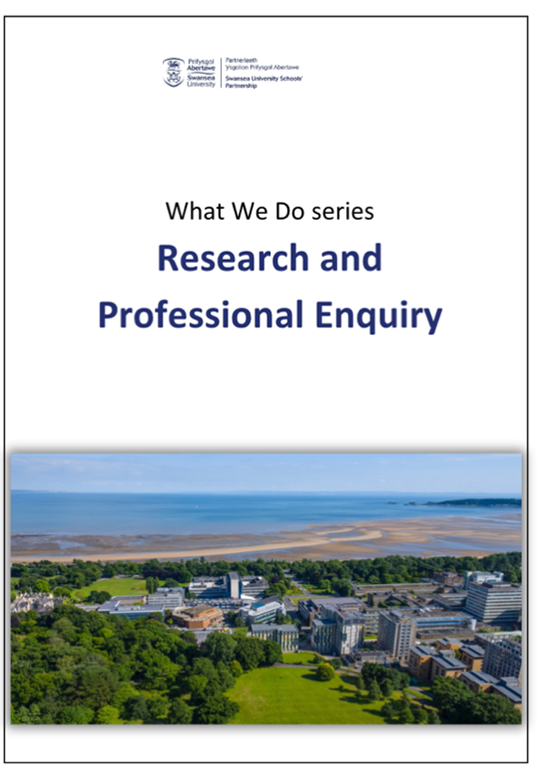The valuable integration of research and enquiry throughout the programme

Quick links:
Information about the school/provider
The Swansea University Schools’ Partnership comprises the University of Swansea, fourteen lead schools and fifty network schools situated in south and west Wales. In the university, the partnership is based in the Department of Education and Childhood Studies which sits within the School of Social Sciences and the Faculty of Humanities and Social Sciences.
The partnership provides two programmes. The PGCE Secondary programme was accredited by the Education Workforce Council (EWC) in 2020 to offer nine subjects: biology, chemistry, physics, computer science, design and technology, English, mathematics, Modern Foreign Languages, and Welsh. Following accreditation, the PGCE Primary programme began in 2022.
Both PGCE programmes are full-time, one-year courses. The primary programme and all subject routes on the secondary programme are offered with options to study through the medium of Welsh.
Context and background to the effective or innovative practice
The Swansea University Schools’ Partnership’s (SUSP) vision is to develop research-informed, reflective practitioners through its PGCE secondary and primary programmes, introduced in 2020 and 2022 respectively. The vision was conceived in the context of the Welsh Government’s increasing support for educational research and professional enquiry (Welsh Government, 2021).
To ensure that the partnership had the capacity to deliver its vision, the programmes were designed to make the most of the wider university research expertise. A departmental Centre for Research into Practice (CRIP) was established as the main channel to support educational research. CRIP places a strong emphasis on making findings accessible to end-users and developing collaborative research with schools and other partners.
Dedicated materials were developed to introduce students systematically to the nature, scope, ethics, and methods of educational research. Drawing on a clinical practice approach, assignment briefs were created so that students could pursue their close-to-practice enquiries in school contexts supported by mentors (Harris et al., 2020). A PGCE ‘House Style’ was created, following input from the Swansea Academy for Learning and Teaching on learning design theory (Laurillard, 2012). This has helped to promote consistent opportunities for students to undertake a range of learning approaches, including investigations, within their taught sessions.
University leaders invested significantly in the staffing and infrastructure to support educational research. This included the appointment of a dedicated Research Officer and the building of two observation classrooms to facilitate small-scale research. Further support has been provided through generous professional development allowances, the funding of staff doctoral research, and a programme of regular research seminars.
What impact has this work had on provision and learners’ standards?
Feedback from school partners and other sources suggests that research and professional enquiry are seen as central to the life of the partnership. Programme teams make close links between theory, research and reflective practice in university, school and other educational settings such as museums, parks and galleries. As a result, student teachers develop their research and critical reflection in a variety of contexts and by using different methods. Examples include research speed dating, involving academics from the wider Faculty, and network discussions of school-based research. Teacher educators, in both university and partner schools, model and promote the value of research and enquiry. Where appropriate, this includes reflecting on the benefits and challenges of doing their own research. All members of the ITE department undertake original research in areas such as digital technology, assessment and feedback. University leaders ensure that the environment facilitates and celebrates research. They keep staff informed about research news and opportunities through regular Faculty bulletins, presentations, online material, workshops and funding opportunities. They also monitor research impact in different ways; for example, senior ITE leaders observe tutors’ research use in taught sessions and discuss professional development opportunities arising from this to inform research strategy.
At a programme design level, teacher educators, school partners and leaders collaborate to support students develop research skills and positive dispositions. Students are also motivated by the choice to pursue their own enquiry-based assignments. The research culture extends across and beyond the partnership. Many members of the department engage effectively in pan-Wales research collaborations to meet national priorities (see CRIP website). Impactful innovations across the partnership include the Young Educational Researchers Network (YERN), where school research leads work with the university to develop children’s research skills. Independent reports by Estyn (2024) and the Welsh Heritage Schools Initiative (2024) highlight the learning gains for participating schools and the wider community. Former students also contribute to the partnership’s research projects. For example, PGCE secondary alumni participate in a long-term study of how the programme has equipped them for the early years of their teaching career. Their feedback to date suggests that they have benefited considerably from the research skills and dispositions to support their classroom practice.
How have you shared your good practice?
The CRIP website publicises the department’s research across a range of themes, such as early years, leadership, parents’ engagement and well-being. Termly seminars are held related to these themes to which all stakeholders are invited. Blogs, videos, infographics, animations and visual summaries have been shared across and beyond SUSP to make accessible the findings from various research projects. The annual CRIP conference is the highlight of the research calendar when researchers at all levels come together to share their findings. This includes all the student teachers and their programme teams. They are joined by staff from across the university, school research leads, representatives from local consortia and the Welsh Government, and teacher educators from other universities. Children and young people from primary and secondary schools also share their research alongside education professors.
Weekly bulletins are sent to all partner schools, and these often feature research events and calls for expressions of interest to participate in collaborative research projects. PGCE primary student teachers take the lead in writing and editing an annual bilingual newsletter, Ymlaen, that features research news.
Events such as the departmental writing retreat supports teacher educators at different stages of research; for example, early career researchers have published blogs and professional articles on topics such as why applicants to the PGCE Secondary programme choose a Welsh pathway, while more experienced researchers have time to plan for peer-reviewed publications. The department’s wide-ranging research expertise means that there are also regular opportunities to learn from staff who act in specialist positions such as journal editors.
Members of the primary and secondary teams have presented at various internal and external conferences. The latter includes those hosted by the Education Workforce Council, Universities’ Council for the Education of Teachers and the British Educational Research Association (BERA). For instance, university and school partners have co-presented at BERA (2024) on how the PGCE primary programme values and develops pupil voice through their participation in interviewing PGCE applicants, contribution to university sessions, and taking the lead for parts of the Practice and Theory days. Several ITE staff have presented at international conferences, while others work closely with colleagues from other ITE providers on Wales-facing national research projects.
The open access publication What We Do: Research and Professional Enquiry, hosted on the CRIP website, provides further information, including case studies featuring ITE team members working with partner schools and the wider department.

References
Estyn Report (2024) Brackla Primary school. Cardiff: Estyn
Harris, A., Jones, M., Lewis, H., Lucas, N. & Thomas, J., (2020) “Designing an Integrated Programme of Initial Teacher Education: Progress, Considerations and Reflections”, Wales Journal of Education. 22(1), 142-163.
Laurillard, D. (2012) Teaching as a Design Science. London: Routledge.
Welsh Government’s (2021) National Strategy for Educational Research and Enquiry, Cardiff: Welsh Government.